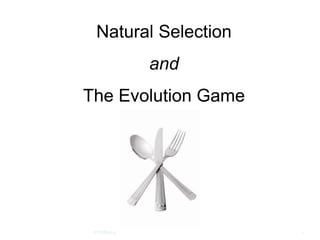
Lab 8 natural selection fall 2014
- 1. Natural Selection and The Evolution Game #NSB2014 1
- 2. After successfully participating in this lab, you will be able to: Explain how predation affects reproduction. Explain how reproduction affects evolutionary fitness. Describe factors that affect individual survival. Demonstrate the difference between individual and species survival. Estimate the evolutionary fitness of a species by interpreting population data. #NSB2014 2
- 3. What is Evolution? Evolution simply means change over time. Evidence that life has evolved: Fossils, DNA, similarities in morphology of different species #NSB2014 3
- 4. This does not mean that humans evolved from monkeys Imagine how many generations would occur in a million years #NSB2014 4
- 5. #NSB2014 5
- 6. Genealogy of Dogs #NSB2014 6
- 7. #NSB2014 7
- 8. Extinct Hominids – look who survived #NSB2014 8
- 9. #NSB2014 9
- 10. For Natural Selection to occur: 1.) There must be variation in traits between individuals within a population 2.) The traits must be heritable. 3.) Certain variants of the trait must be more advantageous than others 4.) Those with the most advantageous variants are more likely to survive and reproduce (evolutionary fitness) #NSB2014 10
- 11. For Natural Selection to occur: You cannot "will yourself" to get an adaptation. The adaptations must naturally occur in populations. For example, if a species of butterfly is orange, and a mutation occurs that makes a butterfly red, if red helps the organism survive, then it will be passed on to offspring. Happens over millions of years, thousands of generations. The Earth is 4.6 billion years old –that's a long time for organisms to change. #NSB2014 11
- 12. Charles Darwin • Theory of Natural Selection •"those individuals who possess superior physical, behavioral, or other attributes are more likely to survive than those which are not so well endowed.“ •In plain English – “Survival of the Fittest” means the most well adapted organisms will survive to reproduce. #NSB2014 12
- 13. Darwin and the Galapagos Islands Darwin compiled evidence for natural selection from decades of observations around the world. This is why it is referred to as the Theory of Natural Selection – not just a guess. Most famous for studying tortoises and finches on the Galapagos Islands 600 miles from South America—ancestral species migrated to islands and adapted to many different island environments over millions of years #NSB2014 13
- 14. Giant Galapagos Tortoises #NSB2014 14
- 16. Leaf, or Insect??? Adaptation: Camouflage #NSB2014 16
- 17. COEVOLUTION Yucca Moth and Yucca plant coevolved for pollination, a mutually beneficial relationship Cheetah and Gazelle Coevolved for SPEED. One to outrun the other. #NSB2014 17
- 18. The Peppered Moth Prior to the industrial revolution, selection favored light-colored individuals; the dark phenotype was rare #NSB2014 18
- 19. •Industrial Revolution (late 1800’s) = more soot and pollution •Sulfur dioxide emissions kill light-colored lichens. •No lichens = dark-colored environment favorable for dark-colored moths to blend into and avoid predation! •More dark-colored variants survive; today there are many more dark individuals! #NSB2014 19
- 20. How many moths can you see? #NSB2014 20
- 21. THE EVOLUTION GAME Objectives After successfully participating in this lab, you will be able to: • explain how predation affects reproduction. • explain how reproduction affects evolutionary fitness. • describe factors that affect individual survival. • demonstrate the difference between individual and species survival. • estimate the evolutionary fitness of a species by interpreting population data. #NSB2014 21
- 22. Why do we play a game in lab? Simulation Taking a class of 640 Natural Science students out into the field to observe predator/prey interactions would be very expensive (to go to the Galapagos would be $10,000 each) Predators/Prey never act like they do in nature when confined to lab This game is fun and actually informative #NSB2014 22
- 23. Change to 60 #NSB2014 23
Notes de l'éditeur
- Mention that darwin concluded that these finches had a recent common ancestor
- The case of the Peppered Moth in Manchester, England is a well-documented study demonstrating the value of camouflage in Natural Selection and the continuing process of evolution. This case involves two variations of the same organism, a white-colored phenotype and a black-colored phenotype. Scientists have determined that a single gene controls the body color of the peppered moth. The dark phenotype is controlled by a dominant allele, which means that a moth possessing at least one such allele will have a dark body. (Each individual will have alleles - one from each of its parents.) To have a light body, the moth must have both alleles for light body color.
- This change in the environment caused the white moths to become more visible and more likely to be eaten by birds, while the black form became better camouflaged. This situation led to a decrease in the population of white moths while the black moths were better able to breed and therefore increase in number. In 1848, the dark moths comprised 1% of the population and by 1959 they represented ~90% of the population. So, in 100 years the frequency of dark moths increased by 1000 fold!
- Prior to the industrial revolution, the white moths comprised 99% of the moth population. The white moths were protected by their ability to blend with the light-colored lichens, which lived on the bark of trees. The black moths were visible against the light background and therefore more susceptible to being eaten by birds. In fact, the dark moths only comprised 1% of the population. Consequently, the black variety did not have as great a chance to reproduce and increase their numbers. The white variation was more fit. Thus the frequency of the dark allele was very low (about .001%), maintained primarily by spontaneous mutation from light to dark alleles.
